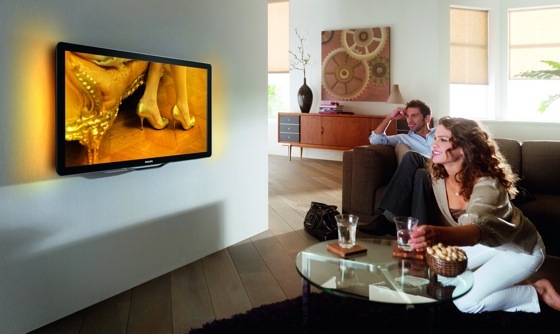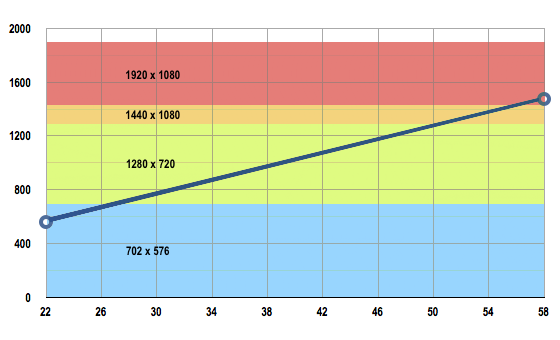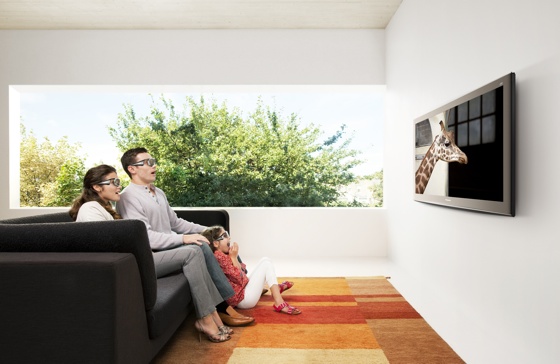Original URL: https://www.theregister.com/2011/05/19/tv_sizes_deconstructed/
How to choose the right screen size
Is your telly too small - or too big - for HD?
Posted in Personal Tech, 19th May 2011 11:23 GMT
How big is big enough? It’s a question many of us have asked, as we cruise the aisles of Currys or John Lewis, looking for a new TV. It’s all too easy to be seduced by a special offer, or by extra features like net connectivity, and end up with a TV that’s larger than you anticipated.
And while you might make space for a jumbo set in the living room, is it actually worth it? Even if you’re watching a 1080p movie on Blu-ray Disc, rather than the over-compressed mush broadcast by some Freeview channels these days, can your eyes actually make sense of what you’re seeing, or are those extra pixels just wasted?

Are you sitting comfortably? And close enough?
Reg Hardware asked me to discover whether or not size really matters when it comes to your HD TV.
Measure for measure
There are three key factors involved: the size of your TV set, the ability of the human eye to perceive visual detail, and how far away from your screen you sit. A 2004 BBC Research and Development department whitepaper reported an mean – and median – viewing distance of 2.7 metres.
How far, Reg Hardware readers, do you sit from your screen?

LG reckons you should sit between 1.2m (22in set) and 4.6m (60in set)
Realistically, TV makers, broadcasters and other experts can give all the guidance in the world, and it won’t make a huge amount of difference. For most of us, unless we’re creating a room specifically for watching TV, the telly is going to go in one of a couple of places, and we’re going to carry on sitting in the same place.
Hands up who’s rearranged their living room to move all the chairs closer to the screen after buying an HD set? Anyone?
Is Full HD really necessary?
As well as asking BBC staff how far they sat from their TV sets, the researchers ran a second set of tests to determine how much detail the human eye can resolve. This was done with a series of test images, and methodology that’s described in some detail in the whitepaper.
Essentially, it involved comparisons between series of filtered and unfiltered images, and the result was broadly in line with the accepted figure of one minute of arc - 1.054, to be precise.
In fact, the BBC research wasn’t strictly concerned with viewing distance, but with what quality of image needed to be broadcast, based on the ability of the eye to discern detail, at the median viewing distance of 2.7m (8.9ft). And the results are quite surprising:
Spotting the Detail
Picture resolution vs screen size

Plot resolution (vertical axis) against screen size and, at an average distance of 2.7m, viewers can't see the difference between 1080p and 720p for the most common TVs
Source: BBC
For the vast majority of viewers, a resolution of 1280 x 720 - 720p - will be sufficient for screen sizes of up to 50 inches diagonal, while 1440 x 1080 may suffice 50-56in screens – a figure that may perhaps influence the decision to broadcast some BBC HD services with a horizontal resolution of 1440 rather than 1920 pixels, though it's also to do with maintaining a 4:3 aspect ratio - which contains an anamorphic picture that stretched to the correct dimensions by a widescreen telly.
And if you’re one of those who feels that you’re being short-changed by the picture quality on some channels, or perhaps someone who simply can’t see what all the fuss is about, a second set of results shows the proportion of people in the test who required a specific standard.
At sizes of 35-40in, it seems that up to around 15 per cent per cent of people will notice a higher quality than 720p, though the proportion noticing anything better than 1440 x 1080 doesn’t increase beyond 15 per cent until screen sizes exceed 45in.
The maths bit
That all assumes the 2.7m viewing distance - if substantial numbers of people really are viewing HD sets much closer than that, perhaps the BBC will need to rethink the decision to broadcast its HD programming at 1440 x 1080 rather than a full HD.

Glasses won't help if you're too far away...
Not everyone’s watching BBC HD, and for many of us, an HD TV is also something to use with games, or for watching Blu-ray and other high definition content. And the real question, rather than ‘what resolution do we need to broadcast’ is ‘how far away should I sit from my TV?’
If you’re interested in working out the answer to that question, it’s not that difficult. I’ve made some assumptions here, chiefly that you have good or corrected eyesight, and that your TV set has an aspect ratio of 16:9.
In fact, the important measurement is really the height of the picture, or H. For a 16:9 screen with a diagonal picture of size D, you can calculate H using Pythagoras:

The generally accepted figure for human visual acuity is one minute of arc, so we need to calculate the distance at which one pixel is equivalent to that.
The simplest way to approximate this is with a triangle where the vertical side is the height of a pixel, p, and the other sides are of equal length. Bisect that triangle at the centre point, and we have a right angle triangle, with the angle at the eye equivalent to 30 seconds of arc, and the distance to the eye is d. A bit of basic trig gives us our next formula:

The fear of all sums
There are 1080 pixels vertically on a full HD set, so we already know that p = H/1080. Calculating the value for the tangent allows us to put in a real number, and we come up with the following formula for the distance:

A quick calculation suggests that for a 37in display, you need to be 57.74 inches away, or a bit short of five foot. Any further and most people won’t notice the difference.
For comparison, using the ITU recommendation of 3H for viewing distance would come up with a distance of 54.41 inches for the same size screen. And if you want to know the viewing distance in metres, starting with your screen size in inches, then use:

If that seems a bit close for comfort, consider 3D viewers, where the recommendation is to sit only 2H away, according to Panasonic. That, I suspect, is unlikely to happen in many living rooms.
Finally, if you have the reverse question, ‘what size TV do I need to buy for my living room’, it’s easy enough to turn around our last formula. Start with the viewing distance, d in metres, and you can find out the diagonal screen size D you need, in inches, using this formula, again only for a 16:9 set. If you want to buy one of Philips’ super-wide models, do your own sums!

Alarmingly, that suggests that if we really are all watching at the 2.7m distance suggested in the BBC internal survey, we need 68in sets to be able to make the most of full HD.
So, how big is yours, and can you really tell the difference? Tell us in the comments. ®